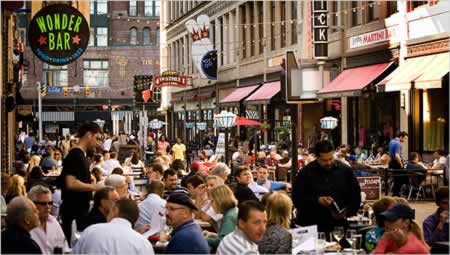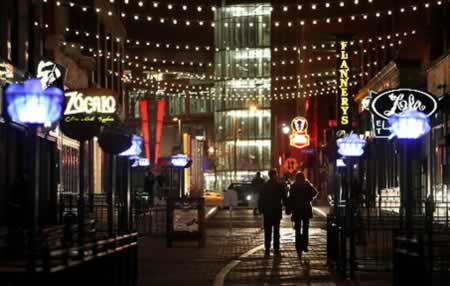
Barney Taxel for The New York Times
The place of the personal, the family and human branding in building place(s): The Marons | Cleveland
During the course of Girvin’s work, over the range of the last several decades, the family connection — in examining, working with and building brands has been a continuing thread. What I’m interested in is the vision of a collective, a group of people, in defining — and listening to community — in building places. Family often times know how to reach a sense of perspective and unity in vision that stands outside the character of conventional corporate structure. Families have an ideal that lies in the DNA of their connectivity to each other, the familial bridge — they can, and will, build visions that are aligned with personal sentiments on creating place, and less so the immediate expectations of cash return on investment. Still, these inherently personal perspectives can yield amazing legacies and results.
Working for, in the Pacific Northwest, the Rowley family of Issaquah (a suburb of Seattle, near the foothills of the Cascade mountain range), along with real estate marketing strategist, Lisa Picard, founder of Muse Development, we had the opportunity to explore not only the principles of the family brand, the Rowley clan, as well as creating an aligned strategy for the progressive development of a group of properties that string from an western boundary creek, eastward to a succession of land holdings that string into a range of adjoining sites. Unlike conventional developers, they’re not in a hurry — taking their time in appropriately assessing the opportunities, planning the property carefully, working with Alan Hart and his group, Via, to examine place-making potentials.
And, as well, they’ve done even more in the planning of their familial extension, moving Kari Magill into the role of CEO, allowing the father founder figure to slide into the consulting role of chairman for the Rowley group. Kari’s planning exemplifies the spirit of the family brand — and extending the family-based principles into, as she puts it: “we believe family and community come first. We work to build our community and focus on projects that rise above the rest – – intelligently developing and creating sustainable projects that will benefit our friends, neighbors and community for years.” That extends to the planning itself, as she notes, “we are establishing a vision and creating a long-term plan for the phased future development of the 60 acres that comprise Hyla Crossing and Rowley Center in Issaquah. We are building a carefully envisioned neighborhood – a richly designed experience for our community and those visiting it. We’ll continue to develop our properties under sustainable strategies that respect our resources and meet the needs of our community, consumers and visitors.” But, being a family, and believing in family, can build out a differing perspective, “We believe in the importance of family – all kinds of family – and growth. Most importantly, we believe in our community!”
This reference in a way focuses on another attribute of our explorations in brand, people, storytelling and place-making: truth. What’s the truth of the brand — and the story that is aligned with it. In working for years with people all over the world, it’s the true brands — as we call them — that last. Brands that are falsely explicated are likely to be smoke in the proverbial pan — eventually, consumer communities figure it out and there (they) go.
There have been other families that we’ve been associated with — the Nordstrom clan, for one; another — the Skinners, the Hedreens, the Sarkowsky family, the Runstads, the Lorig clan, the Oki family. The family bridge goes elsewhere: Ohio and NY, the Horvitz family; Vegas, and the Wynns. There are others, of course, even internationally, like Jakarta.
Many of these families are linked to the proposition of making place — the contexts of living, of retail, of working environments, places to play, to eat, to explore and to enjoy the presence of community. That’s where the differentiation lives, in the spirit of brand — the story that emerges from the flowering ideation of family visioning. It’s different. It’s personal. It’s derived from another form of attitude that presumes continuing personal connections — as Kari Magill notes — the pushes the relationships into the heart of being — not necessarily into the center of commerce. There are strategies in considering the management of the family brand, and there’s a good reference to consider to explore (and download) that idea — in practice and theoretical applications — here.

What caused this meditation came from here, Cleveland, and the work that the Maron family is doing in exploring the concepts of making place, and conscientiously transforming environments. There’s a great deal that’s been written about their newest undertaking, 15 years in the making — which, in the soul of the familial vision, has created a community gathering of phenomenal reclamation. According to the NYTimes, “The Cleveland Plain Dealer, the city’s major newspaper, has characterized as “the jewel of Cleveland’s entertainment district.” About a third of the $110 million project is retail space and two-thirds is housing. The redeveloped area has 14 restaurants, eight bars, a 16-lane bowling alley, a coffee shop, a theater, a nightclub and a concert stage that attracts national acts. Above the restaurants, the developer, the Cleveland-based MRN Ltd., has built 322 rental apartments. The last 64 units were finished in March and are being offered at attractive prices. A 1,200-square-foot apartment with two bedrooms and a bath goes for $1,200 a month, for example, said Ari Maron, 31, a partner in the family-owned company. The current vitality of Fourth Street is the culmination of 15 years of work by the Maron family to turn a worn thoroughfare and its old buildings into a prime example of 21st-century urban redevelopment in the Midwest.”
The character of branding is invariably about people — and in a way, we believe that brand is people — that the personality components of any human brand — whether it’s one person as the founding leadership, a family commitment to vision and direction, a team of leaders — it’s always reaching back to the center, the soul, the warmth of the human.
I’m looking.
tsg
….
Brandstory: the pattern of making place
https://www.girvin.com/blog/modernism-decoration-and-patterning-in-placemaking/
the work: https://www.girvin.com
blogs: https://www.girvin.com/blog
https://tim.girvin.com/index.php
profiles:
TED community | profile: http://www.ted.com/index.php/profiles/view/id/825
LinkedIn: http://www.linkedin.com/in/timgirvin
Facebook: http://www.facebook.com/people/Tim-Girvin/644114347
Twitter: http://twitter.com/tgirvin